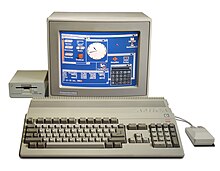

Portal maintenance status: (May 2019)
|

Amiga is a family of personal computers introduced by Commodore in 1985. The original model is one of a number of mid-1980s computers with 16- or 16/32-bit processors, 256 KB or more of RAM, mouse-based GUIs, and significantly improved graphics and audio compared to previous 8-bit systems. These systems include the Atari ST—released earlier the same year—as well as the Macintosh and Acorn Archimedes. Based on the Motorola 68000 microprocessor, the Amiga differs from its contemporaries through the inclusion of custom hardware to accelerate graphics and sound, including sprites and a blitter, and a pre-emptive multitasking operating system called AmigaOS.
The Amiga 1000 was released in July 1985, but production problems kept it from becoming widely available until early 1986. The best-selling model, the Amiga 500, was introduced in 1987 along with the more expandable Amiga 2000. The Amiga 3000 was introduced in 1990, followed by the Amiga 500 Plus, and Amiga 600 in March 1992. Finally, the Amiga 1200 and Amiga 4000 were released in late 1992. The Amiga line sold an estimated 4.85 million units.
Although early advertisements cast the computer as an all-purpose business machine, especially when outfitted with the Sidecar IBM PC compatibility add-on, the Amiga was most commercially successful as a home computer, with a wide range of games and creative software. It also found a niche in video production with the Video Toaster hardware and software, and Amiga's audio hardware made it a popular platform for music tracker software. The processor and memory capacity enabled 3D rendering packages, including LightWave 3D, Imagine, and Traces, a predecessor to Blender.
Poor marketing and the failure of later models to repeat the technological advances of the first systems resulted in Commodore quickly losing market share to the rapidly dropping prices of IBM PC compatibles, which gained 256 color graphics in 1987, as well as the fourth generation of video game consoles.
Commodore ultimately went bankrupt in April 1994 after a version of the Amiga packaged as a game console, the Amiga CD32, failed in the marketplace. Since the demise of Commodore, various groups have marketed successors to the original Amiga line, including Genesi, Eyetech, ACube Systems Srl and A-EON Technology. AmigaOS has influenced replacements, clones, and compatible systems such as MorphOS and AROS. Currently Belgian company Hyperion Entertainment maintains and develops AmigaOS 4, which is an official and direct descendant of AmigaOS 3.1 – the last system made by Commodore for the original Amiga Computers. (Full article...)
Refresh with new selections below (purge)
AmigaGuide is a hypertext document file format designed for the Amiga, files are stored in ASCII so it is possible to read and edit a file without the need for special software.
Since Workbench 2.1 an Amiga Guide system for O.S. inline help files and reading manuals with hypertext formatting elements was launched in AmigaOS and based on a viewer called simply "AmigaGuide" and it has been included as standard feature on the Amiga system. Users with earlier versions of Workbench could view the files by downloading the program and library AmigaGuide 34 distributed with public domain collections of floppy disks (for example on Fred Fish collection) or it could be downloaded directly from Aminet Amiga Official Repository on the web. Starting from AmigaOS 3.0 the AmigaGuide tool was replaced with more the complete and flexible MultiView.
AmigaGuide is the default tool for viewing AmigaGuide files used with AmigaOS 2.1, and is also a basic text viewer for ASCII documents. It can handle multiple files thanks to cross-linking tables called XREF.
Multiview is basically a void container and a natural GUI for the various datatypes that open Multiview as a default tool when any media file (including AmigaGuide files) are invoked by mouse clicking and recognized by the existing correspondent datatype. (Full article...)
Daniel J. Barrett (born November 6, 1963) is a writer, software engineer, and musician. He is best known for his technology books, his work with progressive rock band Gentle Giant, and the imaginary computer game BLAZEMONGER.
Barrett has written a number of technical books on computer topics. The most well-known are Linux Pocket Guide and SSH, The Secure Shell: The Definitive Guide. His books have been translated into Czech, French, German, Hungarian, Italian, Japanese, Mandarin, Polish, Portuguese, Russian, and Spanish. (Full article...)
| Other "Did you know" facts... | Read more... |
|
| |
|---|---|
| Main companies |
|
| Compatible hardware |
|
| OS4 software |
|
| Technologies |
|
| Related and historical |
|
| |
|
| |
|---|---|
| Amiga models |
|
| AmigaOne models |
|
| Unofficial 68k models |
|
| Unofficial PPC models |
|
| Amiga prototypes |
|
| Amiga chipsets |
|
| Amiga custom chips |
|
| Hardware |
|
| 3rd Party Hardware |
|
|
| |
|---|---|
| 8-bit |
|
| Amiga |
|
| IBM PC compatibles |
|
| IBM PC compatible laptops |
|
| Prototypes |
|
|
| |
|---|---|
| AROS software |
|
| AROS GUIs |
|
| Related and historical |
|
|
Video games ported by Hyperion Entertainment
| |
|---|---|
| Linux |
|
| Amiga |
|
| Macintosh |
|
| Other articles |
|
The following Wikimedia Foundation sister projects provide more on this subject:
Commons
Free media repository
Wikibooks
Free textbooks and manuals
Wikidata
Free knowledge base
Wikinews
Free-content news
Wikiquote
Collection of quotations
Wikisource
Free-content library
Wikiversity
Free learning tools
Wiktionary
Dictionary and thesaurus



